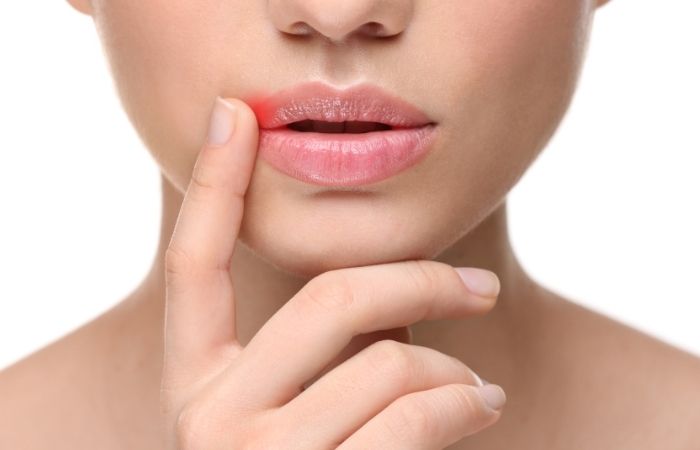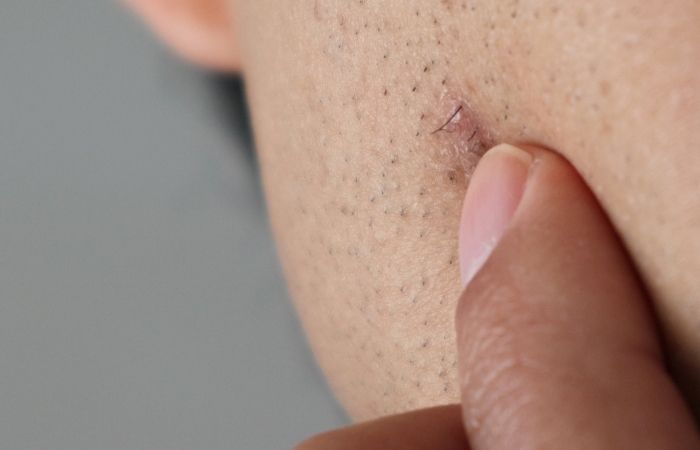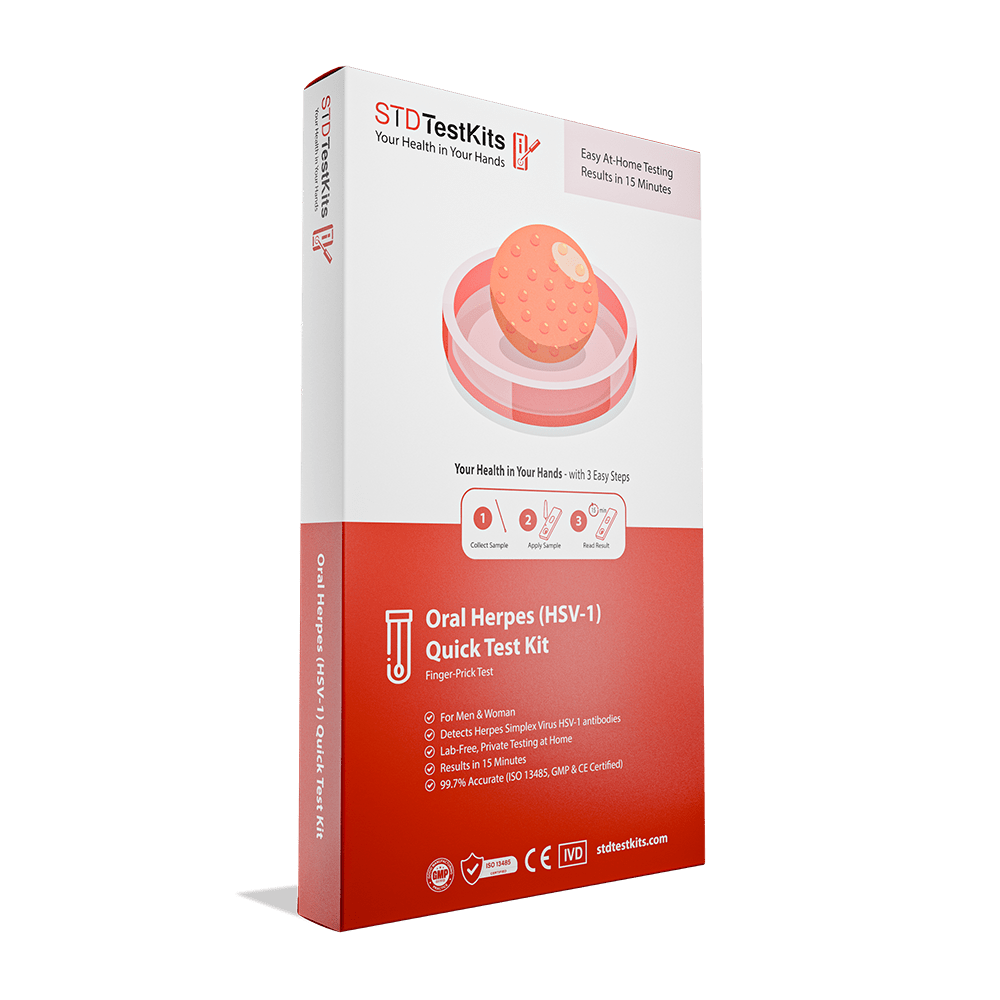You Can Get an STD from Oral Sex, Here’s How It Happens
Quick Answer: Herpes can mimic acne almost perfectly, especially in early stages. If a bump is painful, fluid-filled, reappears in the same spot, or scabs unusually, it might not be a pimple. Testing is the only way to know for sure.
Why So Many People Confuse Herpes with Acne
Herpes is a shapeshifter. Instead of looking like textbook blisters, it can show up as a single pimple-like bump, especially in the early stages of an outbreak. That’s because both acne and herpes involve inflamed pores or follicles. They can both be red, tender, and sit on top of otherwise normal-looking skin. They can both pop up after shaving, sweating, or sex.
The difference? Herpes doesn’t play by acne’s rules. It’s caused by a virus, not clogged pores or bacteria, and it follows a pattern that acne doesn’t. Herpes bumps tend to cluster, may burn or tingle before they appear, and often return in the exact same spot.
But the real kicker is this: many people with herpes don’t know they have it. They assume the first outbreak was “a bad zit,” and by the time it returns, the virus has settled in. That’s why understanding the subtle signs matters, especially if you’re sexually active or prone to breakouts in areas herpes likes to live.

People are also reading: How Long After Exposure Can Chlamydia Be Detected?
Visual Comparison: Herpes vs Acne
Let’s break down how herpes and acne differ visually, behaviorally, and in how they show up over time. If you’re staring at a bump and wondering whether to worry, this table can help guide your next step.
Table 1. Symptom and visual comparison of acne and herpes.
Important note: Some cases of herpes don’t blister at all, especially with mild first infections or recurring outbreaks. They might just look like irritated skin, which makes visual ID even harder without testing.
“I Thought It Was a Pimple, It Was Herpes”
Jordan, 25, had been dealing with hormonal acne since college. So when a sore appeared near his pubic area, he didn’t think twice.
“I shaved that morning,” he said. “It looked like an ingrown hair. A little red bump with some irritation. Totally normal.”
But it didn’t go away. The bump got angrier. It started to hurt, not just to touch, but even when his clothes rubbed against it.
“I put some salicylic acid on it. Bad idea,” he laughed. “It got worse.”
By day four, it scabbed over in a way pimples usually don’t. That’s when he got tested. The result? Positive for HSV-2.
“Honestly, I wasn’t even mad. I was relieved to know. And now I know what to look for, and how to prevent spreading it. But man… herpes looks sneaky. I would’ve never guessed.”
Why Herpes Doesn’t Always “Look Like” Herpes
We’ve been taught that herpes looks like a dramatic, painful cluster of blisters, but that’s not always true. In fact, most first-time outbreaks are mild, and many don’t involve visible sores at all. And for those who do get symptoms, they’re often mistaken for:
- Ingrown hairs
- Friction burns
- Shaving irritation
- Allergic reactions
- Mosquito or spider bites
Herpes can look like a lot of things because skin is reactive, and when it comes to areas like the mouth, groin, or buttocks, people don’t examine closely or frequently. It’s easy to assume “just a zit” and move on. Until it comes back. Or spreads. Or starts to hurt in a way acne never did.
And by then, many people have already passed it to someone else, without ever knowing they had it.
How Herpes Symptoms Progress Over Time
Herpes doesn’t show up all at once. It tends to evolve, sometimes slowly, sometimes dramatically. And if you don’t know what to look for, you might miss the signs. That’s especially true in early infections, where symptoms mimic everyday skin issues or disappear entirely.
Here’s how a typical herpes outbreak plays out:
Table 2. Timeline and symptom stages of a typical herpes outbreak.
Compare this to acne, which usually goes from a clogged pore to inflammation to popping and healing. Acne doesn’t typically ulcerate or scab unless it’s picked harshly. Herpes, on the other hand, follows a more viral pattern, with or without visible sores.
Where Acne Ends and Testing Begins
If your bump doesn’t act like regular acne, or if it returns in the same exact place, testing is your next move. And no, you don’t have to go to a clinic and explain your symptoms to a stranger. At-home herpes tests let you check privately, from wherever you are. Some detect antibodies in your blood, others detect active virus on the skin with a swab.
Here’s when it’s worth testing:
- You’ve had a painful bump that came and went in an unusual way
- You’ve noticed tingling or nerve pain around the area before the bump appeared
- You’ve had sexual contact (oral, genital, or anal) with someone new and now have symptoms
- Your “pimple” crusted or scabbed like a cold sore
- You’re seeing bumps recur in the exact same spot
Even if your bump is gone, you can still test. Blood-based herpes tests look for antibodies, not the sore itself. Just keep in mind: it can take a few weeks after exposure for those antibodies to develop, so if you test too early, you might get a false negative.
Protecting Partners When You’re Not Sure
This part’s tricky, but important. If you’ve got a mystery bump and you're sexually active, your safest move is to press pause until you know what’s going on. That doesn't mean cutting off intimacy forever, it just means avoiding skin-to-skin contact around the area while it’s active or healing.
Herpes spreads through direct contact with skin, not just intercourse. That means rubbing, oral, even shared towels or razors in some cases. You don’t have to see an open sore for herpes to be contagious. The virus can shed invisibly.
Until you test and confirm, these precautions help keep your partner safe:
- Don’t pop or pick the bump, it increases spread risk and delays healing
- Use a barrier method like condoms or dental dams during all sexual activity
- Avoid direct skin contact with the affected area
- Consider antiviral medication if diagnosed, it lowers transmission risk by about 50%
Honesty matters too. You don’t need to confess your entire sexual history. But if you suspect herpes or are waiting on a test, letting your partner know can be an act of care, not fear.

People are also reading: How Soon After Sex Can You Test for HSV-1 or HSV-2?
Why Herpes Stigma Keeps People Misdiagnosed
Let’s be honest: most people don’t think they could have herpes. They associate it with “promiscuity,” poor hygiene, or some other outdated stereotype. That stigma is so strong that people will believe it’s anything else, acne, shaving rash, insect bite, before considering herpes.
This denial delays diagnosis. It keeps people from getting tested. And it helps herpes spread.
But here’s the truth: herpes is a skin condition caused by a virus. That’s it. It’s not a moral failure. It’s not dirty. And it’s not rare. Over 3.7 billion people have HSV-1, and 491 million have HSV-2 globally. Most don’t know. Most never show symptoms. But the virus keeps moving.
Breaking the stigma starts with education. The more we normalize testing and conversation, the fewer people will misdiagnose themselves, and the safer everyone will be.
Real Stories, Real Confusion: Herpes in Disguise
Elise, 33, swore it was a spider bite.
“It showed up on my thigh, just one bump. Hurt to touch. I iced it. Then it turned crusty, then raw.”
She never suspected herpes until it returned, same place, three months later. Swab test confirmed HSV-2.
Darren, 21, thought he had stress acne.
“Finals, bad sleep, junk food. I was breaking out around my mouth. One sore was different, though. Hurt more. Popped and turned yellow. That one was herpes, HSV-1, oral.”
Lina, 27, mistook it for a friction rash.
“We’d had sex in the shower, and I thought I just got chafed. But the irritation stuck around. And then it blistered. I’d never heard of herpes doing that with no warning.”
She now takes antivirals daily and hasn’t had a recurrence in over a year.
These stories aren’t rare. They’re typical. Herpes flies under the radar not because it’s hard to test for, but because it’s easy to ignore.
Living with Uncertainty: The “Almost Symptoms” Nobody Talks About
What if you’re not sure it’s herpes, but you’re not sure it’s not?
That’s the gray zone where anxiety festers. Maybe your bump came and went too fast. Maybe it didn’t blister. Maybe it looked like acne but showed up in a “herpes-ish” spot, near your genitals, lips, or inner thigh. Now you’re Googling every freckle, analyzing every tingle, and spiraling into what-ifs.
If that’s you, you’re not alone. Herpes anxiety is real. But here’s the thing: you don’t have to stay stuck in limbo. You can test. You can track. You can check in with your body and get facts, not fears.
And if it is herpes? You deal. You adapt. You learn that it’s not the end of your sex life, your dating life, or your self-worth. It’s just something to manage, like acne, like allergies, like anything else your skin throws at you.
How to Monitor Your Skin for Recurring Herpes Symptoms
If you’ve had a mystery bump once, or more than once, it’s worth paying attention. Herpes outbreaks often return to the same area and follow a pattern. Here’s how to track your skin over time:
- Take a photo of the area (with date stamp) each time something appears
- Note any sensations beforehand, itching, tingling, burning
- Track healing time (herpes usually lasts 7–14 days)
- Log any other symptoms, fever, fatigue, swollen lymph nodes
- If the same symptoms return in the same spot, get tested, even if it's healed
This kind of tracking not only helps you advocate for yourself at the doctor’s office, it gives you clarity. And when you understand your own body, you stop guessing. You start deciding.
The Misdiagnosis Zone: When Herpes Looks Like Everything Else
Here’s the dirty secret about skin: it’s bad at telling you what’s really going on. Especially down there, or anywhere you shave, sweat, or rub. Herpes gets misdiagnosed more often than you'd think because it’s constantly playing dress-up as something else.
Let’s walk through the top contenders in the “not actually acne” category that often confuse patients and even clinicians.
Herpes or Razor Burn?
Razor burn shows up fast, typically within hours of shaving. It’s red, sometimes itchy, and appears in a scattered pattern. The skin may feel tender but usually calms down in 24–48 hours. Herpes, on the other hand, tends to come with a warning: a tingle, a weird pressure, or nerve pain before anything surfaces. Then it forms distinct bumps, often painful, and takes over a week to fully heal. If your irritation keeps coming back in the same spot after sex or stress? That’s your cue to look deeper.
Herpes or Cystic Acne?
Cystic acne tends to form deep under the skin. It’s those painful, slow-growing monsters that don’t pop and stick around for days or weeks. They’re more common on the jawline, back, and chest, and don’t usually crust unless forcibly popped. Herpes comes up faster, closer to the skin’s surface, and has a more distinct “blister to ulcer to scab” cycle. Also, cystic acne doesn’t cause flu-like symptoms. Herpes outbreaks often do.
Herpes or a Bug Bite?
Summer hookup, new bump? Could be a mosquito, or not. Bug bites usually itch like crazy and swell around the site. They don’t tingle before showing up and don’t form grouped blisters. If your “bite” turns into a weepy sore, or you get more than one in the same area? Time to question it.
Herpes or Ingrown Hair?
This one’s tricky. Ingrown hairs and herpes both cause bumps that can swell, turn red, and hurt like hell. But ingrown hairs usually have a visible hair trapped inside, or release one when popped. Herpes blisters are typically smaller, more clustered, and filled with clear fluid (not pus). If your bump bursts and crusts over? That’s a viral flag, not a clogged follicle.

People are also reading: Herpes Symptoms but Negative Test? Read This First
FAQs
1. Can herpes really look just like a pimple?
Yep. In fact, that’s why so many people miss it. A first-time herpes sore can show up as a single red bump, maybe tender, maybe not. You might think it’s a zit and slap some acne cream on it, only to find it’s crusting, stinging, and refusing to play by pimple rules.
2. What makes herpes different from regular acne?
Acne usually shows up where you’re oily, face, chest, back, and it’s driven by clogged pores. Herpes, on the other hand, tends to appear near the mouth or genitals and comes with a little drama: burning, tingling, or pain before you even see the bump. Plus, it often returns to the same exact spot.
3. I had a bump that hurt like hell, but it was gone in a few days. Could that be herpes?
Possibly. Herpes outbreaks can be mild or even silent, but when they do flare up, they often come on fast, hurt more than you'd expect, and heal in a very specific pattern. If it crusted over or scabbed weirdly? That’s your cue to test.
4. Why would herpes be on my face? Isn’t it a “below the belt” thing?
Totally fair question, and nope, it’s not limited to the genitals. HSV-1 is the herpes type that causes cold sores, but it can show up on your chin, cheeks, or around the nose too. Oral sex can also transmit HSV-1 to the genitals (and vice versa). Herpes doesn’t care about geography.
5. What if I had one weird bump and it never came back?
That happens more often than you think. Some people only have one noticeable outbreak their entire life. But if you’ve had a painful bump, especially in a “herpes hotspot”, it’s worth checking with a swab test or antibody screen. You don’t need to wait for it to come back to get answers.
6. How soon after exposure can symptoms start?
Herpes can show up as early as 2 days or as late as 2 weeks after exposure… or never. That’s the catch. Some people carry the virus without symptoms for months, or years, before their first outbreak hits. Which is why it’s so commonly missed.
7. Can I pass herpes even if I don’t have a sore?
Yes, and this part sucks. It's asymptomatic shedding. Basically, the virus can be on your skin without any indication. That's why doing protection, popping antiviral pills, and staying away from sex during times of high risk (like tingling or breakouts in the last week) can cut down on passing it on.
8. Should I stop having sex if I think I might have herpes?
You don’t have to swear off sex forever, but if you’ve got an unexplained bump, it’s smart (and respectful) to pause until you know what you’re dealing with. Testing doesn’t take long. And it gives you, and your partner, the ability to move forward with clarity instead of fear.
9. What test actually tells me if I have herpes?
If the bump is still there, a swab test is your best bet. If it’s gone, a blood test can check for HSV antibodies. You can do either at a clinic, or skip the awkwardness and use an at-home Herpes Test that gives you answers privately.
10. If I do have herpes, is my dating life over?
Not even close. Herpes is common, manageable, and doesn’t define you. People date with it every day, and they love, flirt, hook up, and live full lives. Disclosure gets easier with practice, and most of the time? People are way more understanding than you’d expect.
Let’s End the Guessing Game
There’s nothing sexy about bump paranoia. Staring at yourself in the mirror, wondering if that little red dot is just another pimple, or something you’ll carry for life. But the truth is, you don’t have to wonder forever. You can know. You can test. You can take the reins back from fear.
Herpes hides because we don’t talk about it. Because it looks like acne, or a bug bite, or nothing at all. But silence doesn’t protect anyone. Getting tested does. Asking questions does. And you don’t need a doctor’s permission to start that process.
Take back control, quietly, quickly, and without judgment, with a Herpes 1 & 2 Test Kit you can use at home. No waiting room. No awkward questions. Just answers.
How We Sourced This Article: This guide was built using current clinical guidance, peer-reviewed research, and patient experiences to offer clear, trauma-informed insight into herpes misdiagnosis. Around fifteen reputable sources shaped this article; below, we’ve highlighted some of the most relevant and reader-friendly ones.
Sources
1. WHO – Herpes Simplex Overview
2. Facial Herpetic Folliculitis Should Be Considered in the Clinic — PMC
3. Recurrent Herpes Infection with Facial Phenotype — PMC
4. Rosacea Fulminans with Superimposed Herpetic Infection — PMC
5. Differential Diagnosis of Oral and Facial Lesions — PMC
About the Author
Dr. F. David, MD is a board-certified infectious disease specialist with a focus on STIs, stigma reduction, and patient-first education. He believes in meeting patients where they are, without shame or judgment, and helping them make informed, empowered decisions about their health.
Reviewed by: J. Portillo, RN | Last medically reviewed: October 2025
This article is for educational purposes and does not substitute medical advice.







